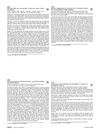Can Male-Pattern Baldness Be Prevented? Promising Results from a Study on Treating Male-Pattern Baldness with Oral Finasteride
July 1997
in “
The Lancet
”

TLDR Finasteride may increase hair growth and prevent baldness in men, but can cause sexual side effects.
Promising results from a study on treating male-pattern baldness with oral finasteride were reported. The study involved 1,879 men aged 18-41 years with stage II or higher androgenic alopecia. They were treated with finasteride for 12 months. The results showed an average increase of 14.0 non-vellus hairs per cm² in the treated group, compared to a decrease of 2.3 hairs per cm² in the placebo group. Global scalp photography indicated that 9% of treated men experienced regrowth of hair, while baldness continued to worsen in 8% of them. Side effects included a decrease in libido in 1.8% of treated men, compared to 1.3% in the placebo group. Erectile dysfunction was also more common in the treatment group (1.3%) than in the placebo group (0.7%).






